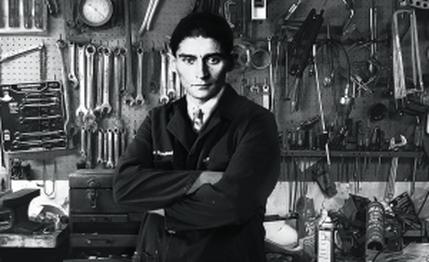Kafka, i disegni, e la bambola viaggiatrice - Kafka, drawings, and the traveling doll
Alcuni disegni realizzati da Franz Kafka
e un racconto di Jordi Sierra i Fabra ispirato a reale episodio della vita di Kafka
Some drawings made by Franz Kafka
and short tale by Jordi Sierra i Fabra inspired by real episode in Kafka's life
Italiano
A 40 anni Franz Kafka, che non si è mai sposato e non aveva figli, passeggiava per il parco di Berlino quando incontrò una bambina che piangeva perché aveva perso la sua bambola preferita. La bambina e Kafka cercarono la bambola senza successo. Kafka le propose di incontrarsi di nuovo lì il giorno dopo, per tornare a cercarla insieme.
Il giorno seguente, non avendo ancora trovato la bambola, Kafka consegnò alla bambina una lettera "scritta" dalla bambola che diceva: "per favore, non piangere. Ho fatto un viaggio per vedere il mondo. Ti scriverò delle mie avventure."
Così iniziò una storia che proseguì fino alla fine della vita di Kafka. Durante i loro incontri, Kafka leggeva le lettere della bambola accuratamente scritte con avventure e conversazioni che la bambina trovava adorabili.
Alla fine Kafka le riportò la bambola (ne comprò una) che era tornata a Berlino.
“Non assomiglia affatto alla mia bambola", disse la bambina. Kafka le consegnò allora un'altra lettera in cui la bambola scriveva: "i miei viaggi mi hanno cambiato”. La bambina abbracciò la nuova bambola e la portò a casa tutta felice.
L’anno seguente Kafka morì.
Molti anni dopo la bambina, oramai adulta, trovò un messaggio dentro la bambola. Nella breve lettera firmata da Kafka c‘era scritto: "tutto ciò che ami probabilmente andrà perduto, ma alla fine l'amore tornerà in un altro modo.
English
At 40, Franz Kafka (1883-1924), who never married and had no children, walked through the park in Berlin when he met a girl who was crying because she had lost her favourite doll. She and Kafka searched for the doll unsuccessfully.
Kafka told her to meet him there the next day and they would come back to look for her.
The next day, when they had not yet found the doll, Kafka gave the girl a letter "written" by the doll saying "please don't cry. I took a trip to see the world. I will write to you about my adventures."
Thus began a story which continued until the end of Kafka's life.
During their meetings, Kafka read the letters of the doll carefully written with adventures and conversations that the girl found adorable.
Finally, Kafka brought back the doll (she bought one) that had returned to Berlin.
"It doesn't look like my doll at all," said the girl.
Kafka handed her another letter in which the doll wrote: "my travels have changed me." the little girl hugged the new doll and brought her happy home.
A year later Kafka died.
Many years later, the now-adult girl found a letter inside the doll. In the tiny letter signed by Kafka it was written:
"Everything you love will probably be lost, but in the end, love will return in another way."
...continua...





.jpg)

